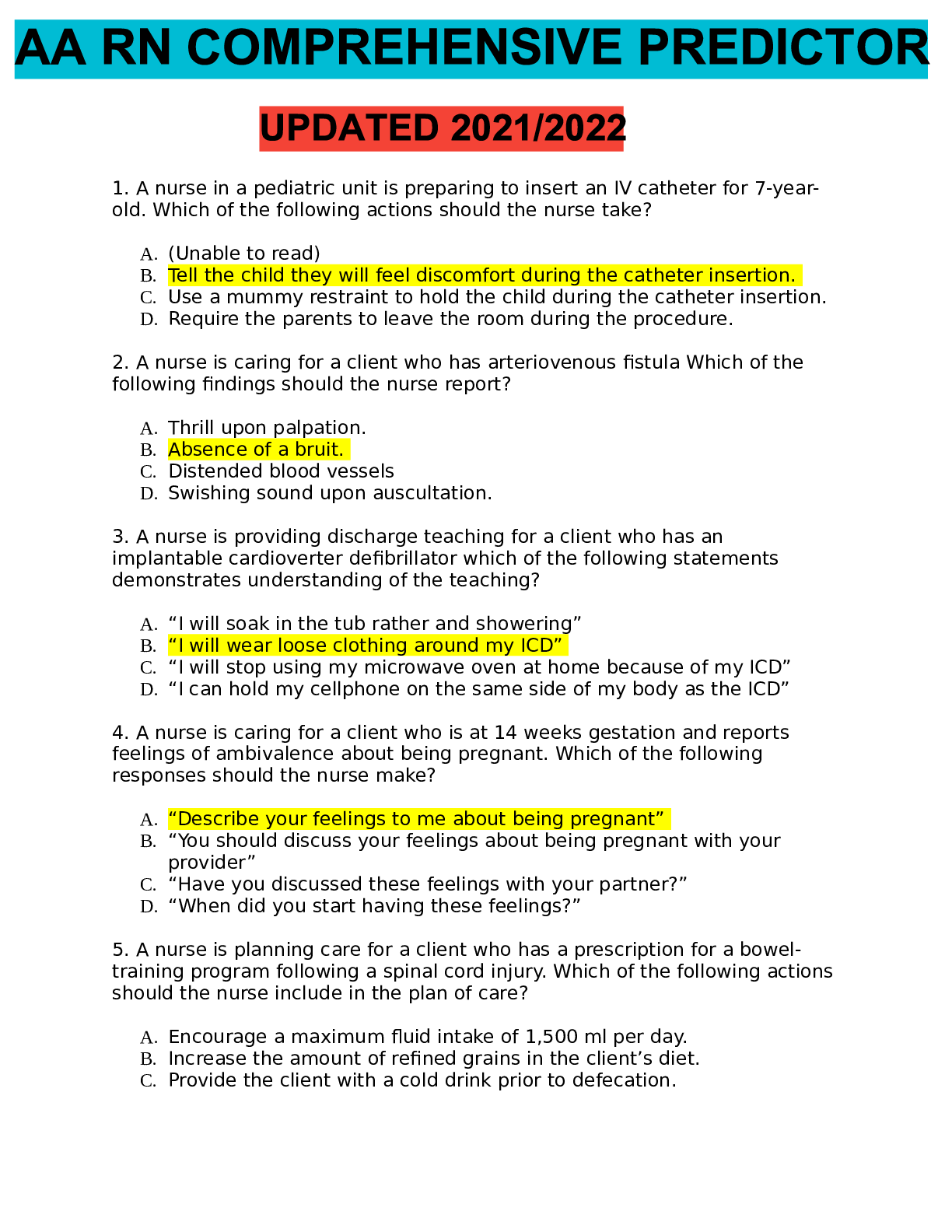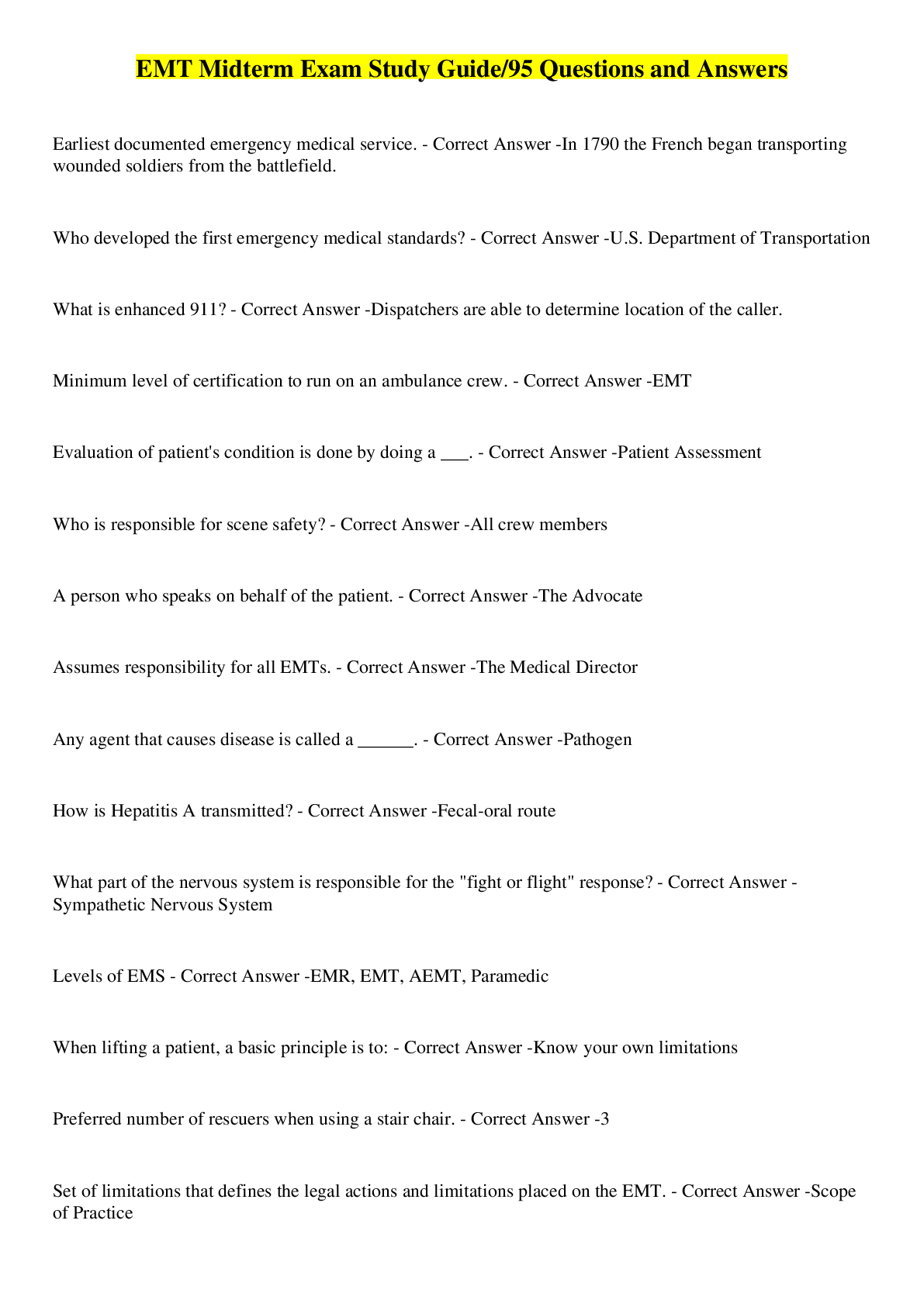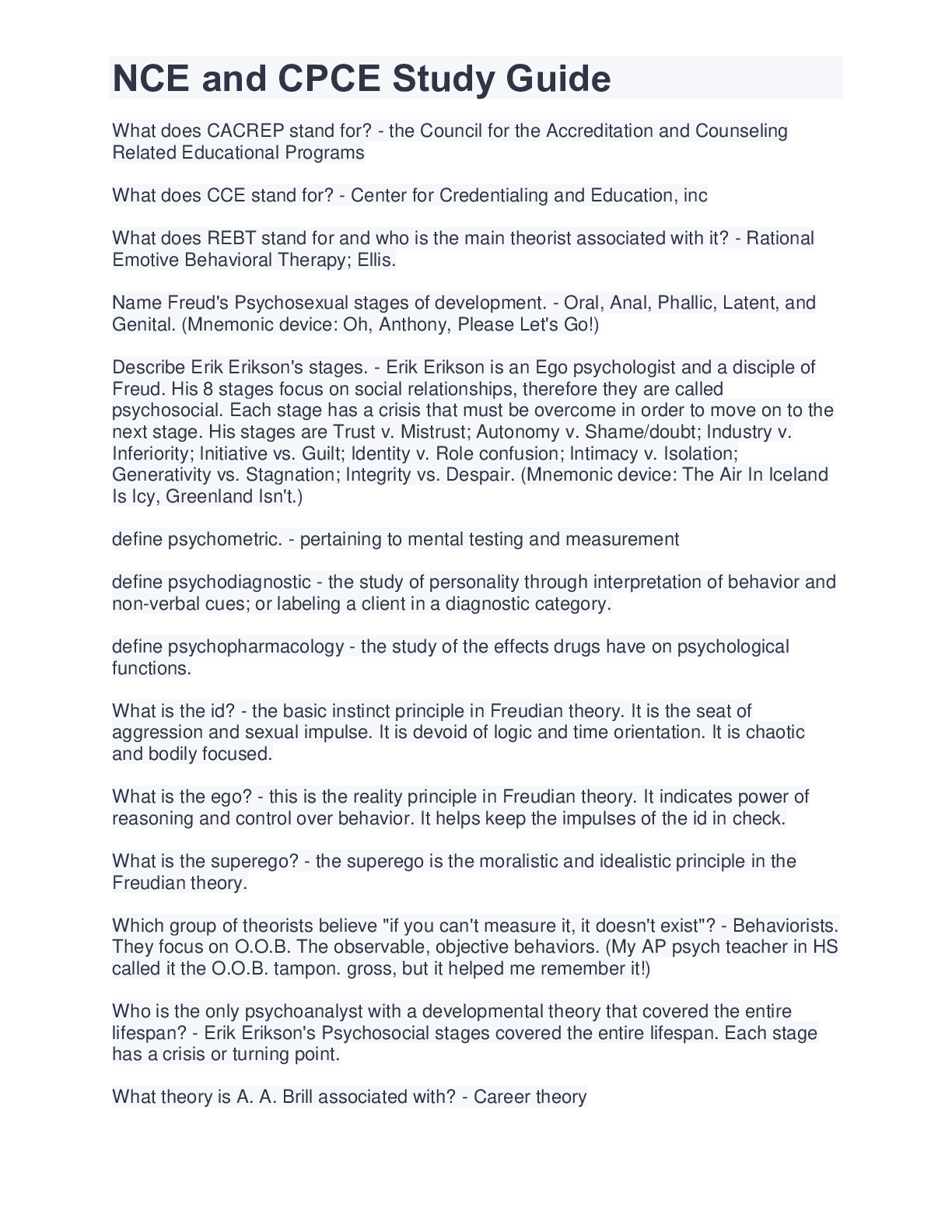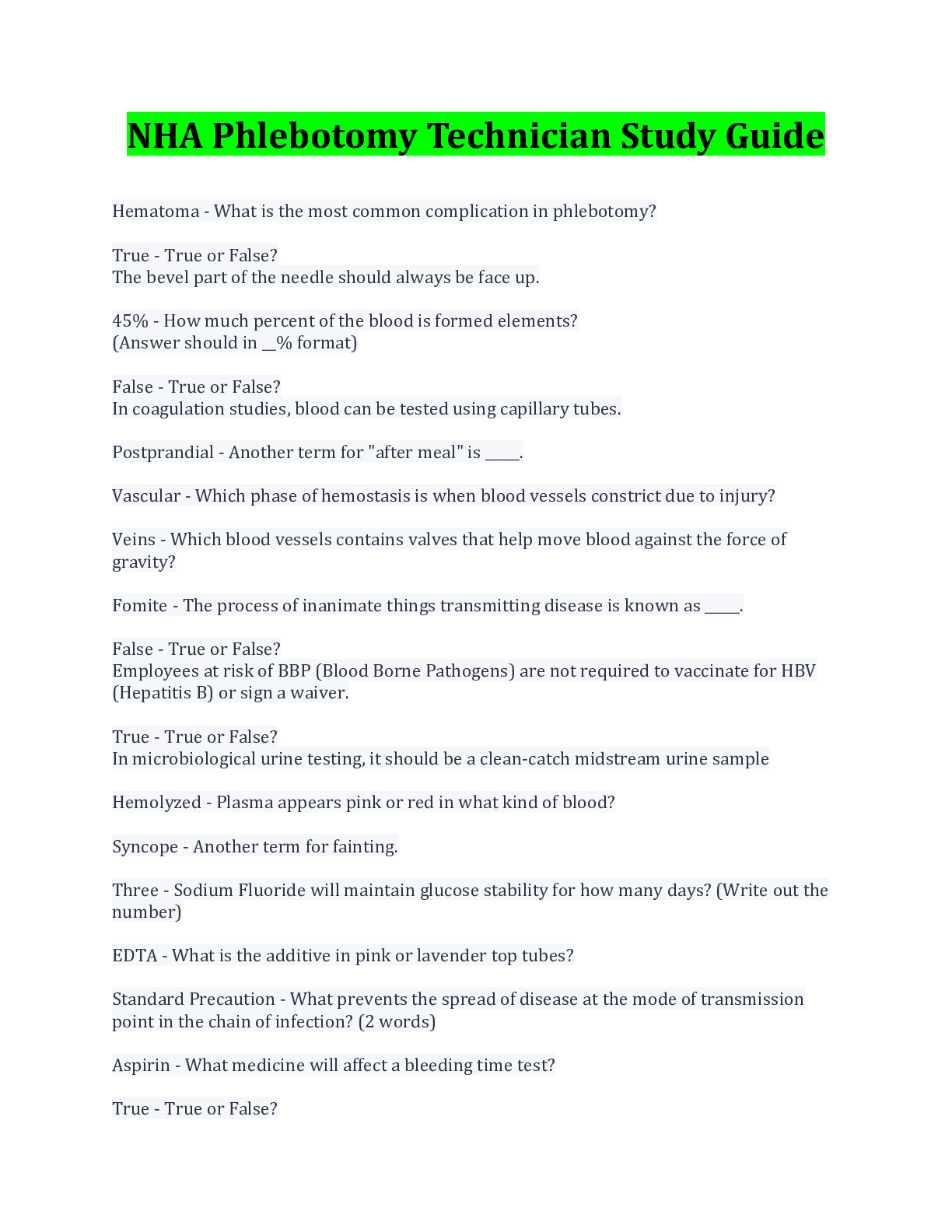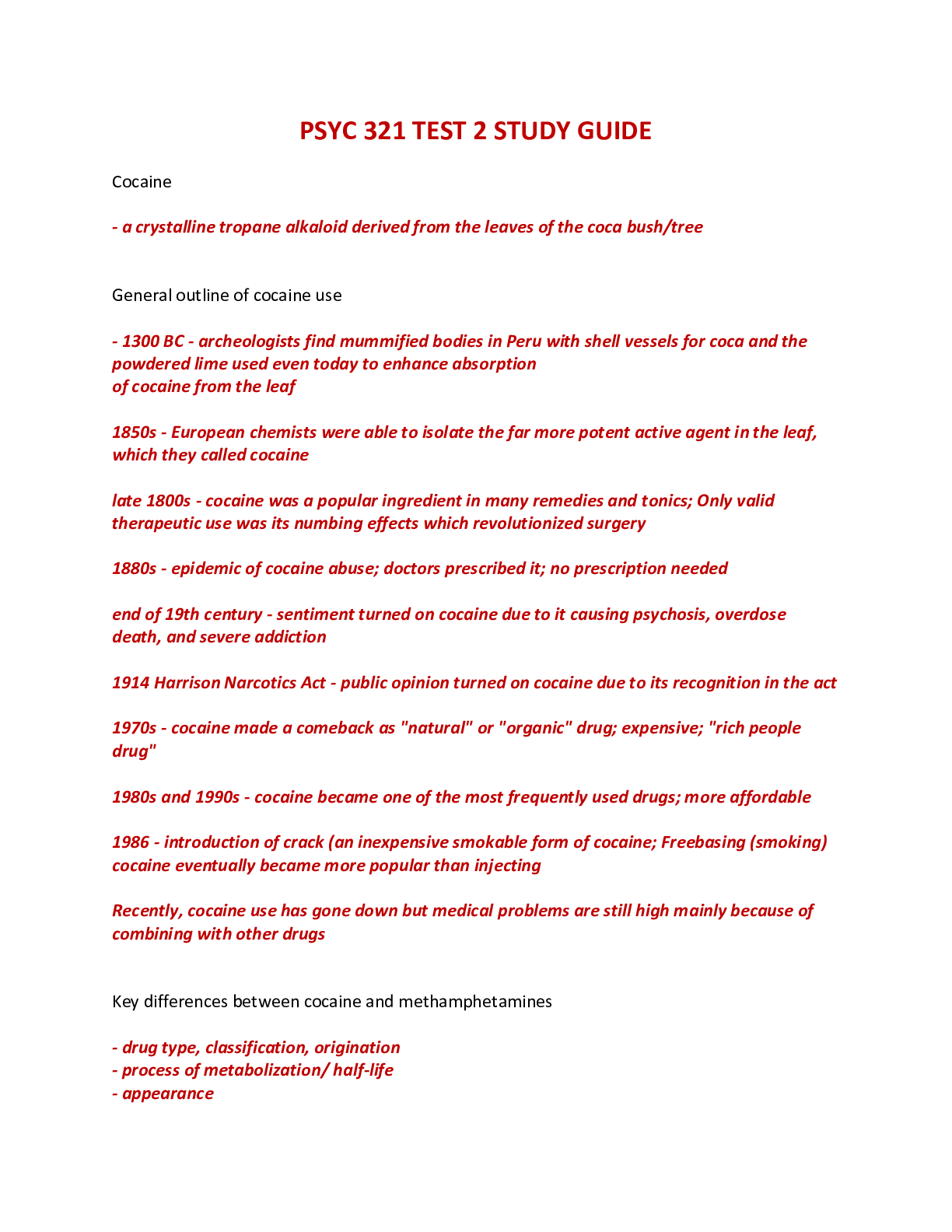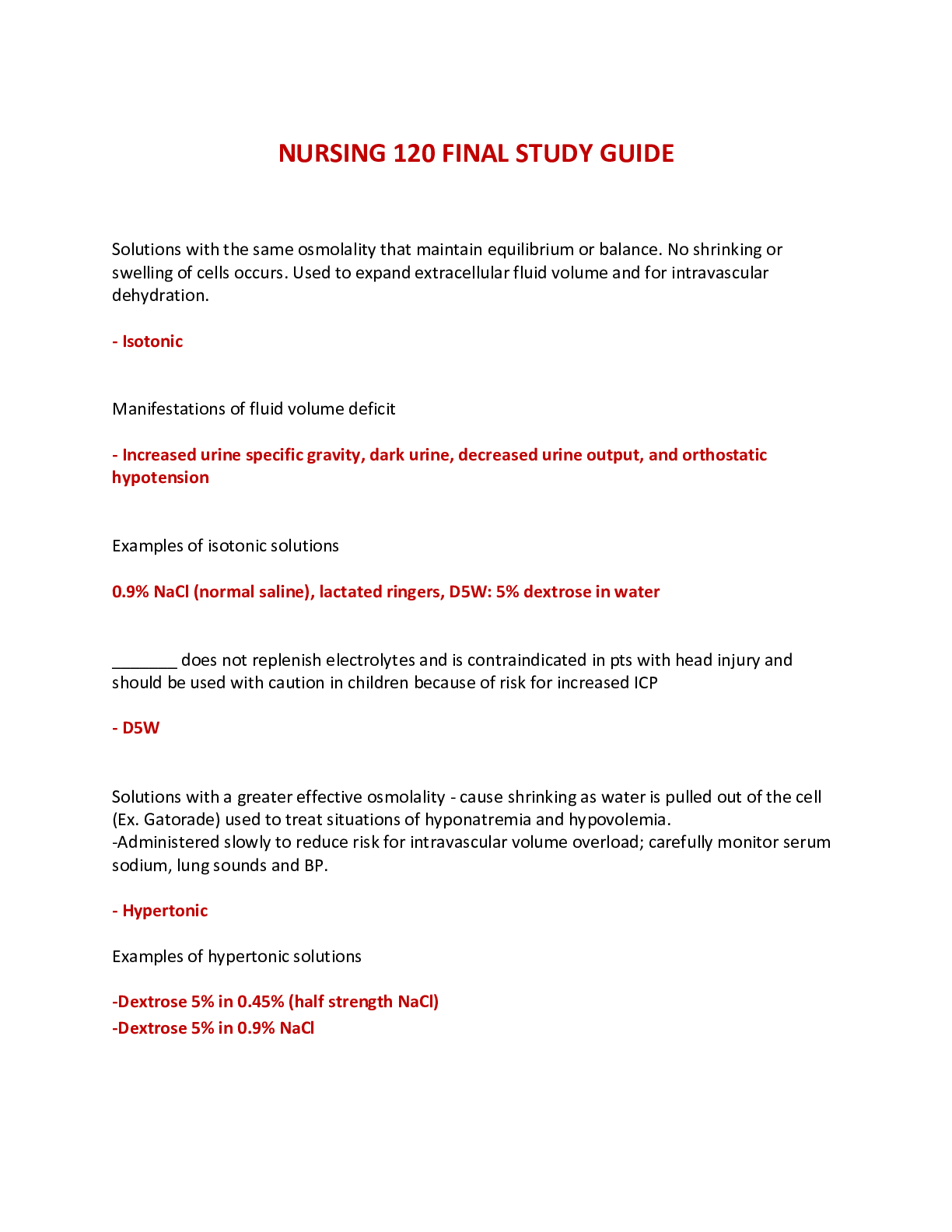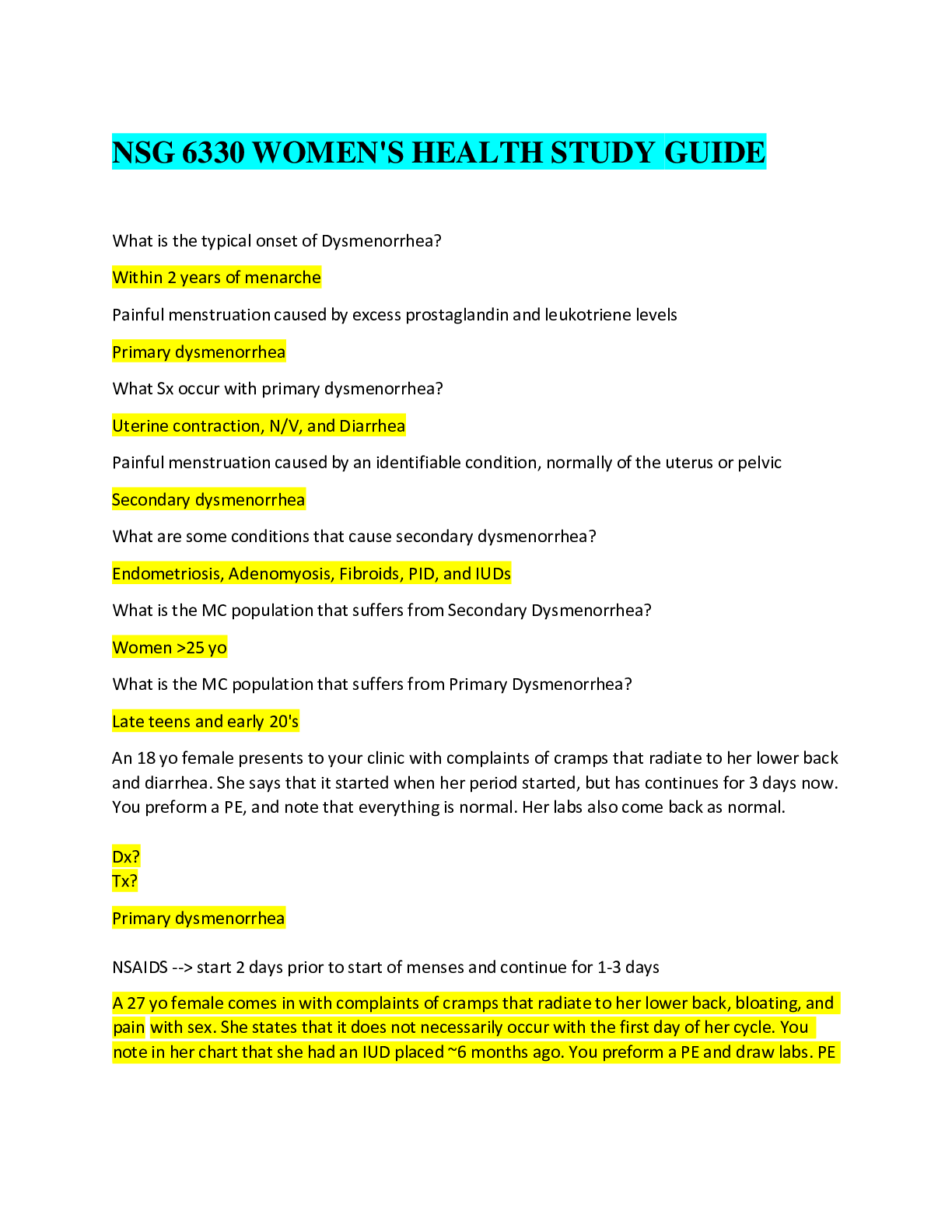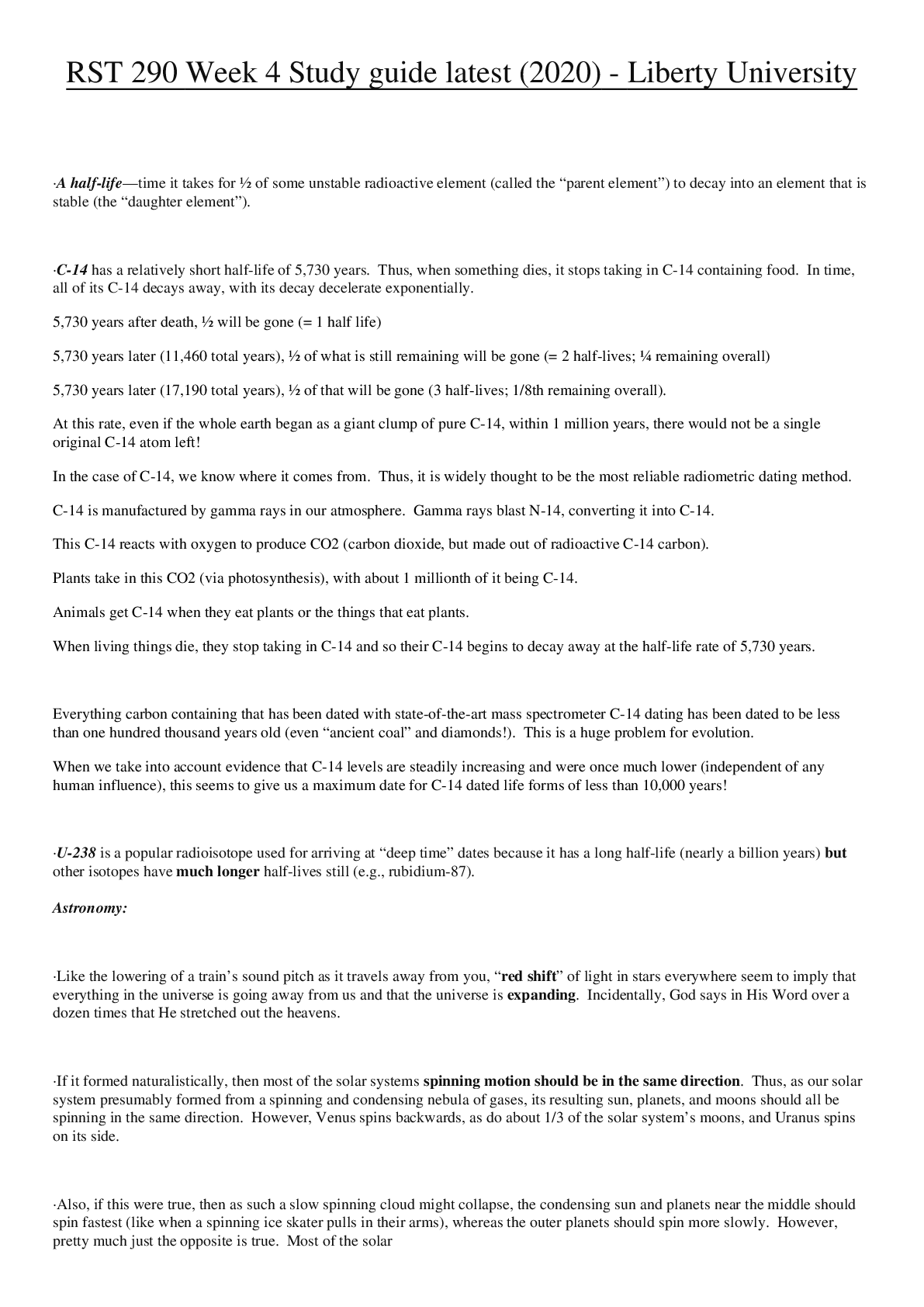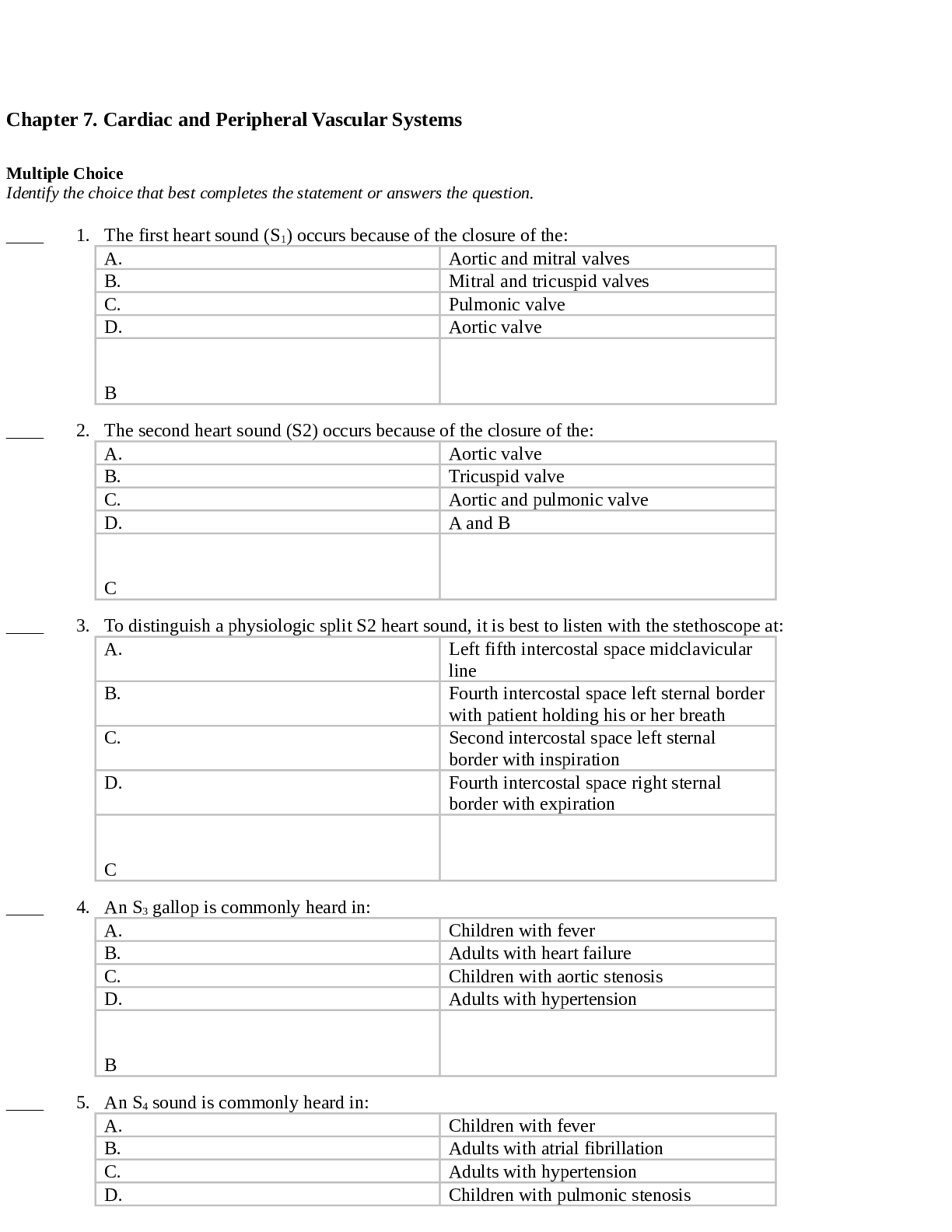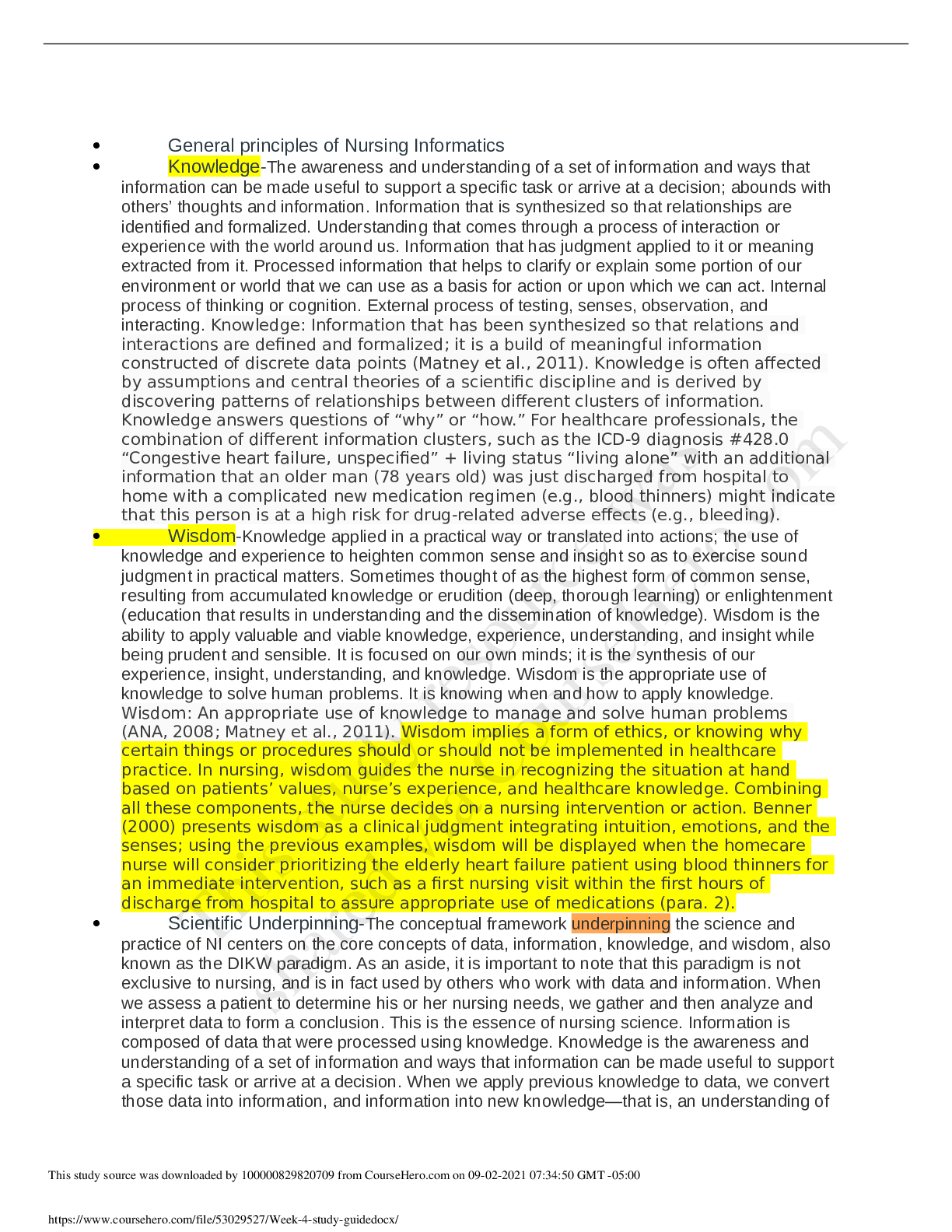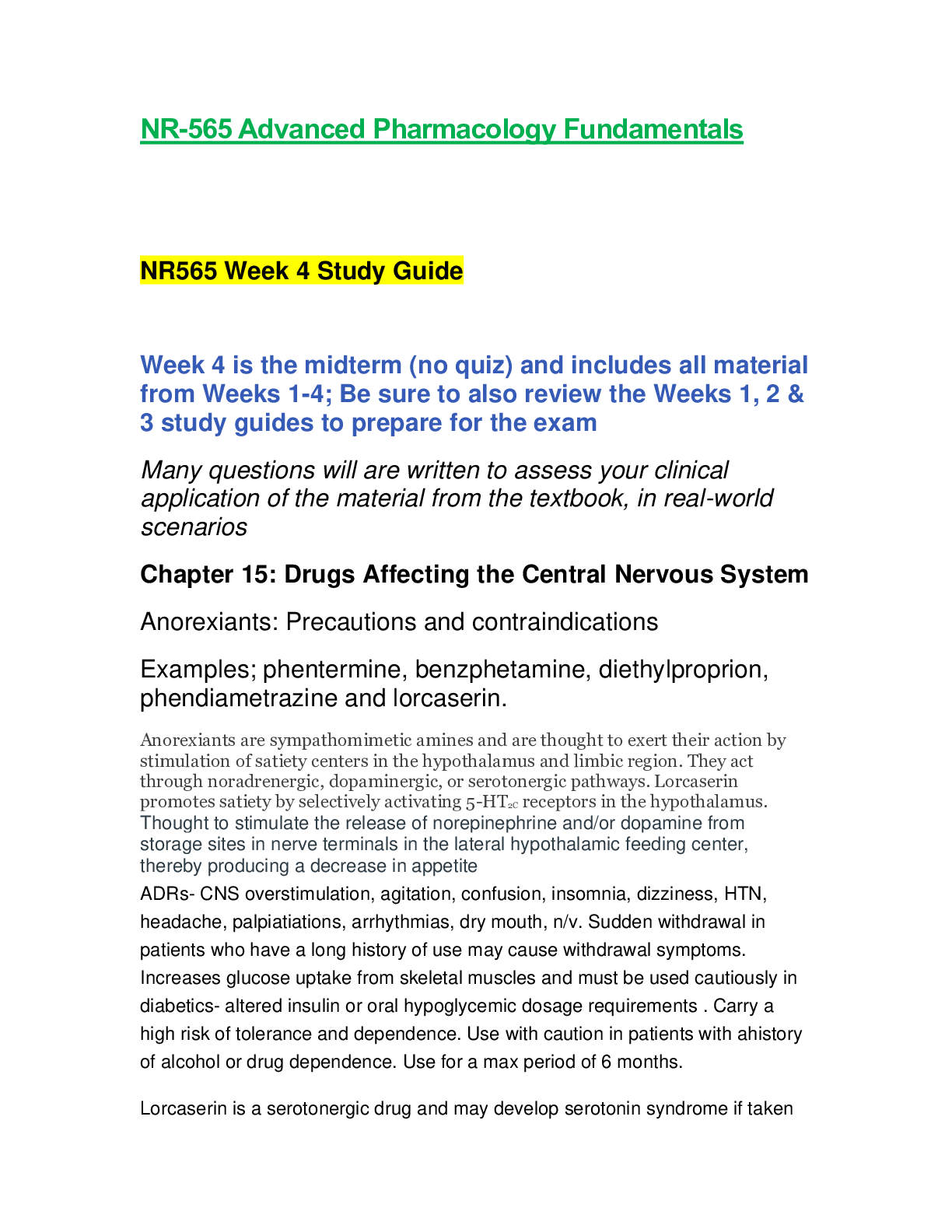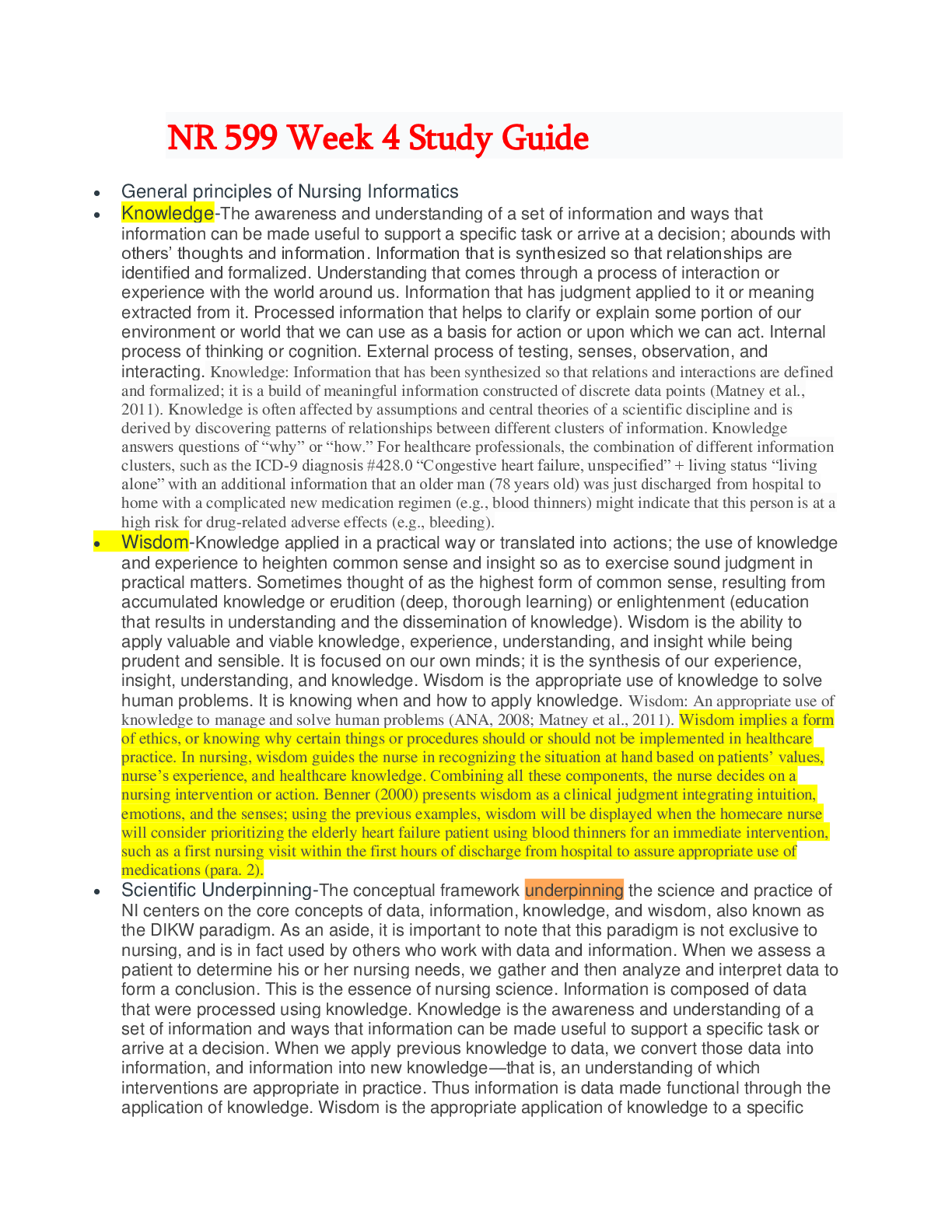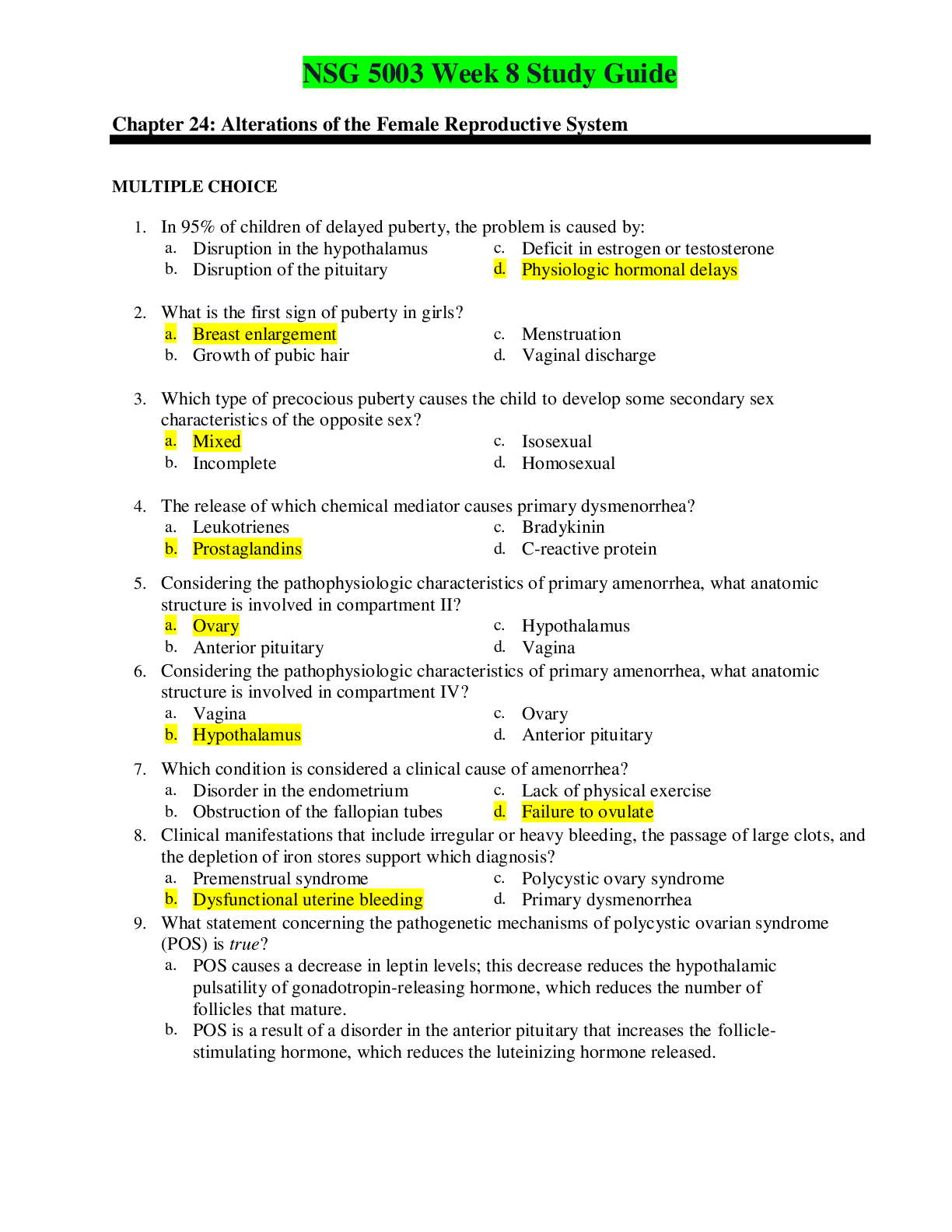*NURSING > STUDY GUIDE > NSG 5003 Week 4 Study Guide - Chapter 30 -32 (All)
NSG 5003 Week 4 Study Guide - Chapter 30 -32
Document Content and Description Below
NSG 5003 Week 4 Study Guide Chapter 30: Alterations of Hematologic Function in Children MULTIPLE CHOICE 1. What is the cause of polycythemia in the fetus? 2. Why does fetal hemoglobi... n have a greater affinity for oxygen than adult hemoglobin? 3. Which blood cell type is elevated at birth but decreases to adult levels during the first year of life? 4. In a full-term infant, the normal erythrocyte life span is _____ days, whereas the adult erythrocyte life span is _____ days. 5. What is the most common cause of insufficient erythropoiesis in children? 6. How does hemolytic disease of the newborn (HDN) cause acquired congenital hemolytic anemia? 7. Erythroblastosis fetalis is defined as an: 8. An infant’s hemoglobin must fall below ___ g/dl before signs of pallor, tachycardia, and systolic murmurs occur. 9. Which vitamin improves the absorption of oral iron taken to treat iron deficiency anemia in children? 10. Hemolytic disease of the newborn (HDN) can occur if the mother: 11. When diagnosed with hemolytic disease of the newborn (HDN), why does the newborn develop hyperbilirubinemia after birth but not in utero? 12. Fetuses who do not survive anemia in utero are usually stillborn with gross edema of the entire body. Which term is used to identify this condition? 13. What is the name of the disorder in which levels of bilirubin remain excessively high in the newborn and are deposited in the brain? 14. What treatment prevents the development of kernicterus in an infant born with hemolytic disease of the newborn (HDN)? 15. Glucose 6-phosphate dehydrogenase (G6PD) deficiency is what type of inherited disorder? 16. Sickle cell disease is classified as a(an): 17. Hemoglobin S (HbS) is formed in sickle cell disease as a result of which process? 18. Sickle cell disease (SCD) is what type of inherited disorder? 19. What is the reason most children diagnosed with sickle cell anemia are not candidates for either bone marrow or stem cell transplants? 20. Which manifestations of vasoocclusive crisis are associated with sickle cell disease (SCD) in infants? 21. What is the chance with each pregnancy that a child born to two parents with the sickle trait will have sickle cell disease (SCD)? 22. Which type of anemia occurs as a result of thalassemia? 23. What is the fundamental defect that results in beta-thalassemia major? 24. The alpha- and beta-thalassemias are considered what types of inherited disorder? 25. Hemophilia B is caused by a deficiency of which clotting factor? 26. Hemophilia A is considered to be what type of inherited disorder? 27. Which disease is an autosomal dominant inherited hemorrhagic disease? 28. Idiopathic thrombocytopenic purpura (ITP) is an autoimmune process involving antibodies attacking which type of cells? 29. Which disorder results in decreased erythrocytes and platelets with changes in leukocytes and has clinical manifestations of pallor, fatigue, petechiae, purpura, bleeding, and fever? 30. When does fetal erythrocyte production shift from the liver to the bone marrow? 31. Which disease is caused by clotting factor VIII deficiency and is an autosomal dominant trait? 32. Which type of hemophilia affects only men? 33. Which hemophilia occurs equally in both men and women? 34. During childhood, when is dietary iron deficiency commonly diagnosed? 35. What is the significance of hyperdiploidy when diagnosing and treating leukemia? Chapter 31: Structure and Function of the Cardiovascular and Lymphatic Systems MULTIPLE CHOICE 1. Which statement does not accurately describe the pericardium? 2. Which cardiac chamber has the thinnest wall and why? 3. Which chamber of the heart endures the highest pressures? 4. What is the process that ensures mitral and tricuspid valve closure after the ventricles are filled with blood? 5. Regarding the heart’s valves, what is a function of the papillary muscles? 6. During the cardiac cycle, why do the aortic and pulmonic valves close after the ventricles relax? 7. Oxygenated blood flows through which vessel? 8. The significance of the atrial kick is that it affects the contraction of the: 9. Occlusion of the left anterior descending artery during a myocardial infarction would interrupt blood supply to which structures? 10. Occlusion of the circumflex artery during a myocardial infarction would interrupt blood supply to which area? 11. The coronary ostia are located in the: 12. The coronary sinus empties into which cardiac structure? 13. What is the ratio of coronary capillaries to cardiac muscle cells? 14. During the cardiac cycle, which structure directly delivers action potential to the ventricular myocardium? 15. What causes depolarization of a cardiac muscle cell to occur? 16. Which event occurs during phase 1 of the normal myocardial cell depolarization and repolarization? 17. Which phase of the normal myocardial cell depolarization and repolarization correlates with diastole? 18. In the normal electrocardiogram, what does the PR interval represent? 19. The cardiac electrical impulse normally begins spontaneously in the sinoatrial (SA) node because it: 20. What period follows depolarization of the myocardium and represents a period during which no new cardiac potential can be propagated? 21. Which complex (wave) represents the sum of all ventricular muscle cell depolarizations? 22. What can shorten the conduction time of action potential through the atrioventricular (AV) node? 23. If the sinoatrial (SA) node fails, then at what rate (depolarizations per minute) can the atrioventricular (AV) node depolarize? 24. What is the effect of epinephrine on 3 receptors on the heart? 25. Where in the heart are the receptors for neurotransmitters located? 26. What enables electrical impulses to travel in a continuous cell-to-cell fashion in myocardial cells? 27. Within a physiologic range, what does an increase in left ventricular end-diastolic volume (preload) result in? 28. As stated in the Frank-Starling law, a direct relationship exists between the _____ of the blood in the heart at the end of diastole and the _____ of contraction during the next systole. 29. Pressure in the left ventricle must exceed pressure in which structure before the left ventricle can eject blood? 30. Continuous increases in left ventricular filing pressures result in which disorder? 31. When the volume of blood in the ventricle at the end of diastole increases, the force of the myocardial contraction during the next systole will also increase, which is an example of which law or theory about the heart? 32. The resting heart rate in a healthy person is primarily under the control of which nervous system? 33. The Bainbridge reflex is thought to be initiated by sensory neurons in which cardiac location? 34. After the baroreceptor reflex is stimulated, the resulting impulse is transmitted from the carotid artery by which sequence of events? 35. Reflex control of total cardiac output and total peripheral resistance is controlled by what mechanism? 36. What is the most important negative inotropic agent? 37. The right lymphatic duct drains into which structure? 38. Where is the major cardiovascular center in the central nervous system? 39. What is an expected change in the cardiovascular system that occurs with aging? 40. What is the major determinant of the resistance that blood encounters as it flows through the systemic circulation? 41. Which function of the cardiovascular system is often affected by ischemia? 42. What physical sign is the result of turbulent blood flow through a vessel? 43. What is the major effect of a calcium channel blocker such as verapamil on cardiac contractions? 44. An early diastole peak caused by filling of the atrium from peripheral veins is identified by which intracardiac pressure? 45. Which intracardiac pressure is generated by the atrial contraction? 46. Which intracardiac pressure is produced because of the descent of the tricuspid valve ring and by the ejection of blood from both ventricles? Chapter 32: Alterations of Cardiovascular Function MULTIPLE CHOICE 1. What is the initiating event that leads to the development of atherosclerosis? 2. What is the effect of oxidized low-density lipoproteins (LDLs) in atherosclerosis? 3. Which inflammatory cytokines are released when endothelial cells are injured? 4. When endothelia cells are injured, what alteration contributes to atherosclerosis? 5. Which factor is responsible for the hypertrophy of the myocardium associated with hypertension? 6. What pathologic change occurs to the kidney’s glomeruli as a result of hypertension? 7. What effect does atherosclerosis have on the development of an aneurysm? 8. Regarding the endothelium, what is the difference between healthy vessel walls and those that promote clot formation? 9. What is the usual source of pulmonary emboli? 10. Which factor can trigger an immune response in the bloodstream that may result in an embolus? 11. Which statement best describes thromboangiitis obliterans (Buerger disease)? 12. Which statement best describes Raynaud disease? 13. What change in a vein supports the development of varicose veins? 14. Superior vena cava syndrome is a result of a progressive increase of which process? 15. What term is used to identify when a cell is temporarily deprived of blood supply? 16. The risk of developing coronary artery disease is increased up to threefold by which factor? 17. Which risk factor is associated with coronary artery disease (CAD) because of its relationship with the alteration of hepatic lipoprotein? 18. Nicotine increases atherosclerosis by the release of which neurotransmitter? 19. Which substance is manufactured by the liver and primarily contains cholesterol and protein? 20. Which elevated value may be protective of the development of atherosclerosis? 21. Which laboratory test is an indirect measure of atherosclerotic plaque? 22. Cardiac cells can withstand ischemic conditions and still return to a viable state for how many minutes? 23. Which form of angina occurs most often during sleep as a result of vasospasms of one or more coronary arteries? 24. When is the scar tissue that is formed after a myocardial infarction (MI) most vulnerable to injury? 25. An individual who is demonstrating elevated levels of troponin, creatine kinase–isoenzyme MB (CK-MB), and lactic dehydrogenase (LDH) is exhibiting indicators associated with which condition? 26. What is the expected electrocardiogram (ECG) pattern when a thrombus in a coronary artery permanently lodges in the vessel and the infarction extends through the myocardium from the endocardium to the epicardium? 27. How does angiotensin II increase the workload of the heart after a myocardial infarction (MI)? 28. The pulsus paradoxus that occurs as a result of pericardial effusion is caused by a dysfunction in which mechanism? 29. A patient reports sudden onset of severe chest pain that radiates to the back and worsens with respiratory movement and when lying down. These clinical manifestations describe: 30. Ventricular dilation and grossly impaired systolic function, leading to dilated heart failure, characterize which form of cardiomyopathy? 31. A disproportionate thickening of the interventricular septum is the hallmark of which form of cardiomyopathy? 32. Amyloidosis, hemochromatosis, or glycogen storage disease usually causes which form of cardiomyopathy? 33. Which condition is a cause of acquired aortic regurgitation? 34. Which predominantly female valvular disorder is thought to have an autosomal dominant inheritance pattern, as well as being associated with connective tissue disease? 35. Which disorder causes a transitory truncal rash that is nonpruritic and pink with erythematous macules that may fade in the center, making them appear as a ringworm? 36. What is the most common cause of infective endocarditis? 37. What is the most common cardiac disorder associated with acquired immunodeficiency syndrome (AIDS) 38. A patient is diagnosed with pulmonary disease and elevated pulmonary vascular resistance. Which form of heart failure may result from pulmonary disease and elevated pulmonary vascular resistance? 39. What cardiac pathologic condition contributes to ventricular remodeling? 40. In systolic heart failure, what effect does the renin-angiotensin-aldosterone system (RAAS) have on stroke volume? 41. What is the cause of the dyspnea resulting from a thoracic aneurysm? 42. Which statement is true concerning the cells’ ability to synthesize cholesterol? 43. What is the trigger for angina pectoris? 44. Individuals being effectively managed for type 2 diabetes mellitus often experience a healthy decline in blood pressure as a result of what intervention? [Show More]
Last updated: 2 years ago
Preview 1 out of 16 pages

Buy this document to get the full access instantly
Instant Download Access after purchase
Buy NowInstant download
We Accept:

Also available in bundle (1)
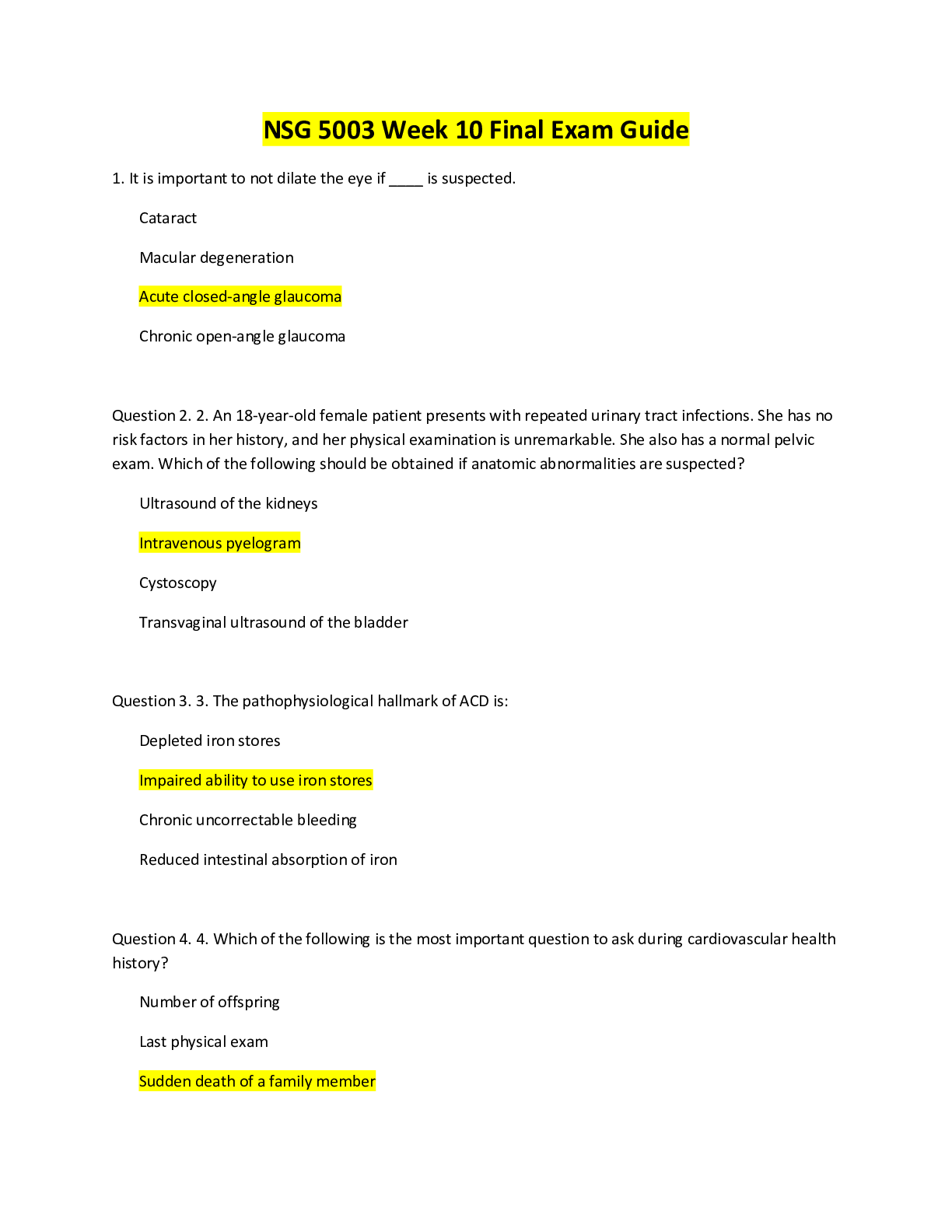
NSG 5003 STUDY GUIDES
Week 4 Study Guide - Chapter 30 -32| Week 9 Study Guide - Chapter 15, 17 -20|Week 2 Study Guide - Chapter 7 - 11|Study Guide - Chapter 1, 2 & 3| Week 6 Study Guide - Chapter 27 - 30|Week 8 Study Guide...
By Ajay25 4 years ago
$42
7
Reviews( 0 )
$15.00
Can't find what you want? Try our AI powered Search
Document information
Connected school, study & course
About the document
Uploaded On
Feb 18, 2021
Number of pages
16
Written in
Additional information
This document has been written for:
Uploaded
Feb 18, 2021
Downloads
0
Views
95



